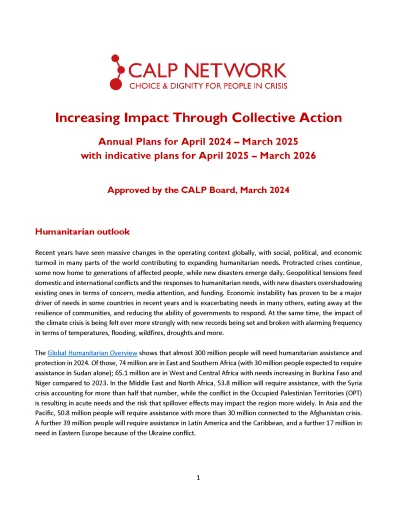CALP Network Annual Plans – 2024-25
Cash is not only more efficient than other forms of humanitarian assistance in most cases, but it’s also the preferred form of support for most people in situations of crisis – creating a compelling need to increases both the use and quality of CVA. CALP’s latest Annual plan, April 2024 to March 2025, brings together an ambitious agenda to drive forward progress. CALP’s Strategy 2020-2025 continues to provide the overall direction for CALP’s work with the State of the World’s Cash 2023 report giving more detailed framing. The strategy outlines the approaches that will be taken to enable ‘impact through collective action’, with the CALP team convening stakeholders for collective influencing, enabling learning exchange, and providing catalytic thought leadership.
In 2024/25, all CALP’s work will be anchored around people centred aid, with plans harnessed around three overarching issues namely increasing the use of CVA; further strengthening quality; and tackling structural issues in the humanitarian system that inhibit progress.
- Increasing the use of CVA. Since most people in crisis prefer cash over other forms of humanitarian assistance, increasing the use of CVA is a people-centred issue which aligns with donor and agency interests in terms of increasing aid efficiency and effectiveness. Research in 2022 explored the barriers and opportunities to increasing the use of humanitarian CVA and found there is no single action that will bring a step change in the use of CVA, rather a myriad of adjustments is needed. For example, pooled funds offer opportunities for increasing the use of CVA with, in some cases, the possibility of more funding being channelled directly to local organizations in this way. Changes to planning are needed, to rebalance the level of investment directed towards in-kind versus CVA preparedness and avoid the availability of stocks being a determinant of modality choice even when cash may be a better option. Equally, changes are needed at donor, headquarters, and response levels to ensure CVA is considered as the default modality where relevant and appropriate. To advance work in this area, CALP will target specific areas of change (e.g. focusing on specific pooled funds) and will seek to amplify impact by sharing learning to encourage wider change.
- Strengthening the quality of CVA. As outlined earlier, the evidence and guidance related to CVA continues to grow but there is a wide gap between good practice and response realities. Focus will be given to increasing the use of evidence-based good practice by facilitating communities of practice, making high quality training resources available, and more. CALP will work with donors, cash working groups (CWGs) and technical advisors to promote the adoption of good practice and will support this by distilling evidence and guidance into easily digestible messages to be shared via multiple communications channels. Existing research and information will be synthesized and, where important evidence gaps exist, new research will be generated in collaboration with stakeholders. For example, work will be progressed to increase understanding of the use of CVA in relation to climate action and bring together learning on CVA and anticipatory action. Equally, while evidence related to efficiency is strong it may need to be refreshed given how the use of CVA has evolved.
- Fostering systems change to enable the potential of CVA. One of the overarching themes in the State of the World’s Cash 2023 report is that structural constraints are inhibiting change. For example, progress towards locally led CVA is slow and requires much greater willingness to shift power and resourcing within the system. Equally, discussion about linking humanitarian CVA and social protection raises questions about the current structure of humanitarian and development funding models. These and many other systems issues need to be addressed for CVA to reach its full potential. CALP will seek to advance systems change by, for example, supporting better and more inclusive coordination structures; and proactively engaging with local actors, ensuring their work is made more visible (through better tracking), recognized and their views heard. Plans also involve engaging with initiatives that may foster wider change, such as the ERC’s Flagship Initiative, the Grand Bargain 3.0; and reviews of donor policies.
Thematic issues that will be addressed will link to, and support, change on one or more of the overarching issues above. The level of effort will vary regionally, depending on local priorities.
Plans will be adjusted during the year according to the needs and priorities of the network. Note: plans are also subject to securing full funding.



